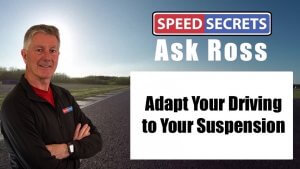 Q: “From a driver standpoint, how do you drive differently in a car with stiff suspension versus soft suspension set-up? What do you feel differently, expect differently, and change how you drive accordingly between stiff and soft suspension?”
Q: “From a driver standpoint, how do you drive differently in a car with stiff suspension versus soft suspension set-up? What do you feel differently, expect differently, and change how you drive accordingly between stiff and soft suspension?”
A: In general, a softer car will have more overall grip, which means you can corner a little faster. But it will also feel more lazy, or less responsive, with initial steering inputs. That’s why some drivers prefer a stiffer setup — because it feels responsive. This is especially important if the track you’re driving has some or many quick direction changes such as esses, or one corner quickly following another.
Many people think that a stiffer setup generates more grip, but that’s not necessarily true. Again, the reason for a stiffer setup is to make the car more responsive. Turn that around, and you might wonder why we wouldn’t then have very, very soft suspension. Two main reasons: First, what I just said about the car feeling lazy and unresponsive (kinda like driving a big old 1950s Buick – if you can imagine that!!). And second, if the suspension is too soft, it’s possible that the geometry could allow the wheels to go into positions that are less than ideal. For example, there could be so much body roll that the suspension allows the wheels to have too much camber change, and ultimately lead to the tires not having as much tread surface on the track.
One other time when a stiffer setup might be an advantage is if your car generates significant aerodynamic downforce from the underbody of the car (think F1, Indy, and prototype sports cars). If the bottom of the chassis is moving around, then the aero downforce will be increasing and decreasing. That’s why F1 cars, for example, are so stiff – to maximize aero downforce.
Some wonder why a softer suspension leads to more overall grip, and it’s a really good thing to understand. Body roll (or lean) does not equate to load transfer (often referred to as weight transfer). In fact, it’s practically the opposite. When the chassis/body rolls or leans, less load is transferred to the outside tires, and that means less is taken off the tires on the inside of the corner. You can picture this by imagining no springs in the suspension (like a go-kart) — all the lateral load transfer would be pushing those outside tires into the track surface, but the inside tires would be almost lifting off the track. The more load on the outside tires, the more traction they gain; the less load on the inside tires, the less traction they have. And here’s the thing: The outside tires do not gain as much as the inside tires lose. I know, weird, right? But it has to do with the way rubber tires work, physics, workloads, and stuff that tire engineers can explain over the course of many hours. I created a short video that turns this concept into something that I think is understandable for drivers – go to Why Is Smooth Fast? to watch it. The bottom line is that a softer setup causes less load transfer, resulting in the car being better balanced, and having more overall grip.
As with almost any part of tuning a car’s setup, it’s a compromise between grip, balance, and responsiveness. And driver’s preference plays a big role in deciding which is best, too. Some drivers like a really responsive car, and others prefer one that provides more feel. See, sometimes with a really stiff setup, it’s hard to tell when the car is going to break away as the tires reach the limit and go beyond it.
Okay, you probably already know all this, and you really just want to focus on the part of your question addressing how to drive the different setups? Since the biggest difference is the responsiveness, the biggest difference in driving technique is how and when you turn the steering wheel. Because a softer setup will not respond as quickly, you may have to turn the steering wheel very slightly earlier, and possibly even a bit quicker of a turn of the wheel. With a stiffer setup, you may need to be a bit slower and more progressive with how and when you turn the steering wheel.
The timing and rate of release of the brakes will likely need to be adapted a bit when switching from a soft to a stiff setup, or vice versa. And so will how you apply and/or breathe the throttle to change the car’s balance in a corner, too. A stiff setup will usually need a finer, more sensitive feel for how you release the brakes because it’s likely to be more reactive to you taking your foot off the brakes. But, with a softer setup, you still need to be smooth because you don’t want to upset the movement of the chassis (which it can do since it is soft). I don’t believe there is a one-size-fits-all piece of advice regarding what you do with the pedals. It’s something you need to pay attention to, feel, experiment with, and adapt to.
That should give you some things to think about, but more importantly, apply to your driving. It takes practice, so be deliberate about how you do that.

